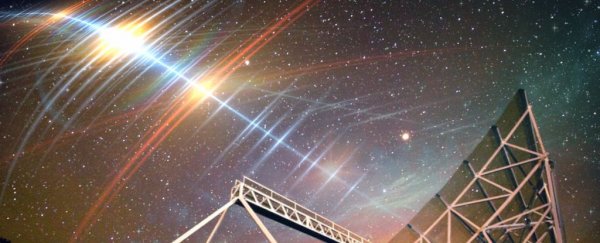A new radio signal from deep space is once again challenging our understanding of these mysterious phenomena.
Not only is this new fast radio burst, named FRB 20191221A, another extremely rare repeater, but it's not even that fast: the radio flashes received across intergalactic space are three seconds in duration, about 1,000 times longer than average.
However, bursts of higher intensity radiation occur every 0.2 seconds within this three-second window – something never before seen in a fast radio burst.
The detection was made by the CHIME detector in December 2019, and scientists immediately knew they were onto something very peculiar.
"It was unusual," said astrophysicist Daniele Michilli of the MIT Kavli Institute for Astrophysics and Space Research.
"Not only was it very long, lasting about three seconds, but there were periodic peaks that were remarkably precise, emitting every fraction of a second – boom, boom, boom – like a heartbeat. This is the first time the signal itself is periodic."
Fast radio bursts are one of the most fascinating current cosmic mysteries. They are extremely powerful busts of radiation in radio wavelengths that flare from intergalactic space in a very short space of time – usually milliseconds in duration. Within that brief blink of time, the burst emits as much energy as 500 million Suns.
Most fast radio bursts flare just once, and haven't been heard from since. These are impossible to predict; to detect one, we just have to hope that one occurs when we have a radio telescope pointed in the right direction (although projects like CHIME, with a large viewing area, are helping immensely in this regard). These are the most common type of FRB.
Much more rarely, repeated signals are received from a single point in the sky. These are the repeating fast radio bursts. Because they repeat, scientists can point a telescope at the sky and study the signals in much greater detail.
It's unclear, however, if the same mechanism is responsible for all fast radio bursts.
They can vary in intensity, wavelength, polarization and dispersion. One fast radio burst holds a significant clue: in 2020, for the first time, a fast radio burst was detected coming from within the Milky Way. It was traced to a type of neutron star called a magnetar, suggesting that these highly magnetized, ultradense objects might be responsible for at least some fast radio bursts.
"CHIME has now detected many FRBs with different properties," Michilli said. "We've seen some that live inside clouds that are very turbulent, while others look like they're in clean environments. From the properties of this new signal, we can say that around this source, there's a cloud of plasma that must be extremely turbulent."
As for what it is, the signs still point to a neutron star of some kind (sorry, still no aliens).
Neutron stars are the collapsed cores of massive stars that have ended their lives and ejected most of their material into space. No longer supported by the outward pressure of fusion, the core collapses into an incredibly dense object, around 20 kilometers (12 miles) across, but up to an estimated 2.3 times the mass of the Sun.
Magnetars are a type of neutron star with an insanely strong magnetic field. Because of the outward pull of this magnetic field competing with the inward pull of gravity, magnetars periodically erupt in massive quakes.
Pulsars are neutron stars that eject beams of radio emission from their poles, spinning at speeds down to millisecond scales so that the beam appears to pulse. Michilli and his colleagues analyzed the bursts from FRB 20191221A and found features in common with emission from magnetars and pulsars.
There's just one problem: although it's unclear how far FRB 20191221A traveled, it has probably come from another galaxy, and its outburst appears to be over a million times brighter than magnetars and pulsars in our own galaxy.
"There are not many things in the Universe that emit strictly periodic signals," Michilli explained. "Examples that we know of in our own galaxy are radio pulsars and magnetars, which rotate and produce a beamed emission similar to a lighthouse. And we think this new signal could be a magnetar or pulsar on steroids."
The team hopes that they might catch some more outbursts from the mystery source of FRB 20191221A to narrow down both where it comes from and what might be causing it. In turn, this could help us better understand neutron stars.
"This detection raises the question of what could cause this extreme signal that we've never seen before, and how can we use this signal to study the Universe," Michilli said. "Future telescopes promise to discover thousands of FRBs a month, and at that point we may find many more of these periodic signals."
The research has been published in Nature.
